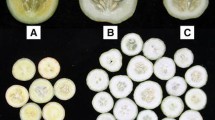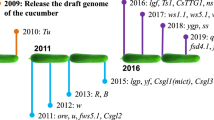Abstract
The nutritional value of cucumber (Cucumis sativus L.) can be improved by the introgression of β-carotene (i.e., provitamin A and/or orange flesh) genes from “Xishuangbanna gourd” (XIS; Cucumis sativus var. xishuangbannanesis Qi et Yuan) into US pickling cucumber. However, the genetics of β-carotene content has not been clearly defined in this US market type. Thus, three previous populations derived from a US pickling cucumber (‘Addis’) × XIS mating were evaluated for β-carotene content, from which the high β-carotene inbred line (S4), ‘EOM 402-10’, was developed. A cross was then made between the US pickling cucumber inbred line ‘Gy7’ [gynoecious, no β-carotene, white flesh; P1] and ‘EOM 402-10’ [monoecious, possessing β-carotene, orange flesh; P2] to determine the inheritance of β-carotene in fruit mesocarp and endocarp tissue. Parents and derived cross-progenies (F1, F2, BC1P1, and BC1P2) were evaluated for β-carotene content in a greenhouse in Madison, Wisconsin. While F1 and BC1P1 progeny produced mature fruits possessing white, light-green, and green (0.01–0.02 μg g−1 β-carotene) mesocarp, the F2 and BC1P2 progeny mesocarp segregated in various hues of white, green, yellow (0.01–0.34 μg g−1 β-carotene), and orange (1.90–2.72 μg g−1 β-carotene). Mesocarp and endocarp F2 segregation adequately fit a 15:1 [low-β-carotene (0.01–0.34 μg g−1): high-β-carotene (1.90–2.72 μg g−1)] and 3:1 (low-β-carotene: high-β-carotene) ratio, respectively. Likewise, segregation of carotene concentration in mesocarp and endocarp tissues in BC1P2 progeny adequately fit a 3:1 (low-β-carotene: high-β-carotene) and 1:1 (low-β-carotene: high-β-carotene) ratio, respectively. Progeny segregations indicate that two recessive genes control the β-carotene content in the mesocarp, while one recessive gene controls β-carotene content in the endocarp. Single marker analysis of F2 progeny using the carotenoid biosynthesis gene Phytoene synthase determined that there was no association between this gene and the observed β-carotene variation in either fruit mesocarp or endocarp.

Similar content being viewed by others
References
Clayberg CD (1992) Interaction and linkage test of flesh color genes in Cucumis melo L. Cucurbit Genet Coop Rep 15:53
Cuevas HE, Staub JE, Simon PW, Zalapa JE, McCreight JD (2008) Mapping of genetic loci that regulated quantity of β-carotene in fruit of U.S. Western Shipping melon (Cucumis melo L.). Theor Appl Genet 117:1345–1359
Cuevas HE, Staub JE, Simon PW, Zalapa JE (2009) A consensus linkage map identifies genomic regions controlling fruit maturity and beta-carotene-associated flesh color in melon (Cucumis melo L.). Theor Appl Genet 119:741–756
Demming-Adams B, Adams WW (2002) Antioxidants in photosynthesis and human nutrition. Science 298:2149–2153
Dijkhuizen A, Kennard WC, Havey MJ, Staub JE (1996) RFLP variability and genetic relationships in cultivated cucumber. Euphytica 90:79–89
Fazio G, Staub JE, Stevens MR (2003) Genetic mapping and QTL analysis of horticultural traits in cucumber (Cucumis sativus L.) using recombinant inbred lines. Theor Appl Genet 107:864–874
Giovannucci E (2002) Lycopene and protaste cancer risk. Methodological consideration in the epidemiology literature. Pure Appl Chem 74:1427–1434
Liu HB (1998) Statistical genomics: linkage, mapping and QTL analysis. CRC Press LLC, Boca Raton
Lu S, Van Eck J, Zhou X, Lopez AB, O’Halloran M, Cosman KM, Conlin BJ, Paolillo DJ, Garvin DF, Vrebalov J, Kochian LV, Küpper H, Earle ED, Cao J, Li L (2006) The cauliflower Or gene encodes a Dna-J cysteine-rich domain-containing protein that mediates high levels of β-carotene accumulation. Plant Cell 18:3594–3605
Mares-Perlman JA, Millen AE, Ficek TL, Hankinson SE (2002) The body of evidence to support a protective role for lutein and zeaxanthin in delaying chronic disease. J Nutr 132:518S–524S
Michelmore RW, Paran L, Kesselli RV (1991) Identification of markers linked to diseases resistance gene by bulked segregant analysis: a rapid method to detect markers in specific genome regions using segregating populations. Proc Natl Acad Sci USA 88:9828–9832
Navazio JP (1994) Utilization of high carotene cucumber germplasm for genetic improvement of nutritional quality. PhD Thesis, University of Wisconsin-Madison
Navazio JP, Simon PW (2001) Diallel analysis of high carotenoid content in cucumbers. J Am Soc Hortic Sci 126(1):100–104
Royal Horticultural Society (2005) The royal horticultural society colour chart. The Royal Horticultural Society, London
SAS Institute (1999) SAS version 8.02 for windows. SAS Institute Inc, Cary
Schwartz SH, Quin X, Zeevaart JD (2003) Elucidation of the indirect pathway of abscisic acid biosynthesis by mutants, genes and enzymes. Plant Physiol 131:1591–1601
Serquen FC, Bacher J, Staub JE (1997) Mapping and QTL analysis of a narrow cross in cucumber (Cucumis sativus L.) using random amplified polymorphic DNA markers. Mol Breed 3:257–268
Simon PW, Navazio JP (1997) Early orange mass 400, early orange mass 402, and late orange mass 404: high-carotene cucumber germplasm. HortScience 32(1):144–145
Simon PW, Wolff XY (1987) Carotenes in typical and dark orange carrots. J Agric Food Chem 35:1017–1022
Staden R, Beal KF, Bonfield JK (1999) The staden package, 1998. Methods Mol Biol 132:115–130
Staub JE, Sun Z, Chung SM, Lower RL (2007) Evidence for colinearity among genetic linkage maps in cucumber. HortScience 42:20–27
Staub JE, Robbins MD, Wehner TC (2008) Cucumber. In: Prohens J, Nuez F (eds) Vegetables I: Asteraceae, Brassicaceae, Chenopodiaceae, and Cucurbitaceae. Springer, New York, pp 241–282
Tatlioglu T (1993) Cucumber Cucumis sativus L. In: Kalloo G, Bergh BO (eds) Genetic improvement of vegetable crops. Pergamon Press Ltd, Tarrytown, pp 197–234
Vuylsteke M, Mank R, Antosine R, Bastiaans E, Senior ML, Stuber CW, Melchinger AE, Lubbersted T, Xia XC, Stam P, Zabeau M, Kuiper M (1999) Two high-density AFLP linkage maps of Zea mays L.: analysis of distribution of AFLP markers. Theor Appl Genet 99:921–935
West CE, Eilander A, van Lieshout M (2002) Consequences of revised estimates of carotenoid bioefficacy for dietary control of vitamin A deficiency in developing countries. J Nutr 132:2920S–2926S
Yang SL, Pu H, Liu PY, Walters TW (1991) Preliminary studies on Cucumis sativus var. xishuangbannanesis. Cucurbit Genet Coop Rep 14:29–31
Author information
Authors and Affiliations
Corresponding author
Rights and permissions
About this article
Cite this article
Cuevas, H.E., Song, H., Staub, J.E. et al. Inheritance of beta-carotene-associated flesh color in cucumber (Cucumis sativus L.) fruit. Euphytica 171, 301–311 (2010). https://doi.org/10.1007/s10681-009-0017-2
Received:
Accepted:
Published:
Issue Date:
DOI: https://doi.org/10.1007/s10681-009-0017-2




